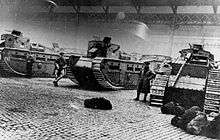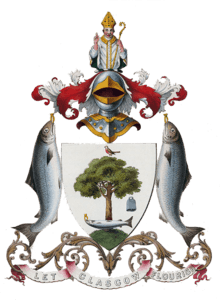Battle of George Square
| Battle of George Square | |||
|---|---|---|---|
| Part of Red Clydeside | |||
 David Kirkwood and Willie Gallacher being detained by police at the City Chambers | |||
| Date | 31 January 1919 | ||
| Location | Glasgow, Scotland | ||
| Caused by |
| ||
| Goals |
| ||
| Methods |
| ||
| Resulted in |
| ||
| Parties to the civil conflict | |||
| |||
| Lead figures | |||
| |||
| Number | |||
| |||
| Casualties | |||
| Many injured | |||
The "Battle of George Square" was a violent confrontation in Glasgow, Scotland between Glasgow City Police and striking Glasgow workers, centred around George Square. The 'battle', also known as "Bloody Friday" or "Black Friday", took place on Friday 31 January 1919[1], 82 days after the end of the First World War. In its aftermath the leaders of the strike were arrested and British troops, supported by six tanks, were moved to key points in Glasgow and its surrounding areas[2].
Forty Hours Strike
The end of the First World War saw the United Kingdom demobilise her military and industry from its war footing, reducing employment. This combined with the increasingly worsening domestic fiscal and monetary environment to create the prospect of mass unemployment. The Scottish TUC and Clyde Workers' Committee (CWC) sought to increase the availability of jobs, open to demobilised soldiers, by reducing the working week, from a newly agreed 47 hours, to 40 hours[3].
The resulting strike began on Monday 27 January, with a meeting of around 3,000 workers held at the St. Andrew's Halls[4]. By 30 January, 40,000 workers from the Clydes engineering and shipbuilding industries had joined. Sympathy strikes also started among local power station workers and miners from the nearby Lanarkshire and Stirlingshire pits. The rapid growth of the action was credited to flying pickets[5], most of whom were recently discharged servicemen. This was Scotland's most widespread strike since the Radical War of 1820[6], which had followed the end of the Napoleonic Wars.
The 'Strike Situation in Glasgow' was discussed by the War Cabinet on 30 January[7]. The meeting was chaired by Bonar Law in the absence of the Prime Minister, Lloyd George. Winston Churchill, Secretary of State for War and Robert Munro, Secretary of State for Scotland, who were not members of the War Cabinet were in attendance, among others.
At the meeting concern was voiced that, given the concurrent European popular uprisings, the strike had the possibility to spread throughout the country. While it was government policy at the time to not involve itself in labour disputes. The agreed action was justified to ensure there was 'sufficient force'[8] present within the immediate locale of Glasgow to secure the continuation of public order and operation of municipal services[9]. The decision to use the armed forces to provide the requested force, in the absence of a declaration of martial law, required those forces be acting on behalf of a civil authority[10]. On the meeting's close, instructions were sent to Scottish Command informing of the situation and to be prepared to deploy troops if requested[11].
The Battle of George Square
On 31 January, a large number of strikers (contemporary estimates range from 20-60,000) congregated in George Square. They were awaiting an answer to a their petition which the CWC had delivered to the Lord Provost of Glasgow some days earlier[12].
Accounts differ on what initiated the violence on the day, but police testimony at the following trials records that the police baton charged the striking workers at 12:20 [13].
As the fighting started in George square, a Clyde Workers' Committee deputation was in the Glasgow City Chambers meeting with the Lord Provost of Glasgow. On hearing the news, CWC leaders David Kirkwood and Emanuel Shinwell left the City Chambers and started towards George Square.
Kirkwood was knocked to the ground by a police baton[14]. Then he, William Gallacher and Shinwell were arrested. They were charged with "instigating and inciting large crowds of persons to form part of a riotous mob"[15][16]. Kirkwood was found not guilty at trial after a photograph was submitted to the court, showing him lying on the ground after being knocked out by police, before reaching George Square and the fighting.
After the baton charge, the outnumbered police retreated from George Square. The fighting between the strikers and police, some mounted, spread into the surrounding streets and continued into the night[17].
Military Deployment

The events of the day prompted the request for military assistance by the Sheriff of Lanarkshire. The deployment had already begun before the day's meeting of the War Cabinet[18], which convened at 3pm[11].
During that meeting Munro, Secretary for Scotland, described the demonstration as 'a Bolshevist uprising'. General Sir Charles Harington Harington, the Deputy Chief of the Imperial General Staff informed the meeting that 6 tanks supported by 100 lorries were 'going north that evening'[11]. It was stated that up to 12,000 troops could be deployed.
The first troops arrived that night[19], with their numbers increasing over the next few days. The six Medium Mark C tanks, of the Royal Tank Regiment arrived from Bovington on Monday 3 February[20].
The troops guarded locations of import to the civil authorities throughout the period of the strike, which lasted until 12 February. The troops and tanks then remained in Glasgow, and its surrounding areas, until 18 February[21].
Outcome
With the strike over, the strikers gave up their cause for a 40 hour work week. Therefore by default accepting the previously agreed to 47 hours.
Key members involved in the strike were arrested in the immediate aftermath of the events of the 31st. William Gallacher and Emanuel Shinwell were sentenced to five months and three months in prison respectively[22].
Emanuel Shinwell, born to a Jewish immigrant family in London, ran in the municipal elections to the Glasgow Corporation following his release from prison[23].
In the General Election of 1922, the second election held after the passage of the Representation of the People Act 1918, Scotland elected 29 Labour MPs. Their number included the 40 Hour Strike organisers and Independent Labour Party members Manny Shinwell and David Kirkwood[24][25]. The General Election of 1923 eventually saw the first Labour government come to power under Ramsay MacDonald. The region's socialist sympathies earned it the epithet of Red Clydeside[26].
See also
| Wikimedia Commons has media related to 1919 Battle of George Square. |
References
- ↑ "The Battle of George Square". The Sunday Post.
- ↑ "Historian Sir Tom Devine calls for monument for George Square workers' uprising". The Sunday Post.
- ↑ "Manifesto of Joint Strike Committee, Glasgow, Feb 1919". Glasgow Digital Library. University of Strathclyde.
- ↑ "The 40 Hours Strike 1919". Glasgow Digital Library. University of Strathclyde.
- ↑ "The last reading of the Riot Act". BBC Scotland. BBC.
- ↑ "Looking back: Scotland's political protests". The Scotsman.
- ↑ CAB 23/9/9, 'War Cabinet, Minutes of Meeting 522, 30 January 1919'
- ↑ The Glasgow Herald, 7 February 1919
- ↑ Pamphlet, Duties in Aid of the Civil Power, WO 32/18921, 'Use of military personnel in aid of civil powers in event of civil disturbances and strikes'
- ↑ The King's Regulations and Orders for the Army (1914)
- 1 2 3 CAB 23/9/9, 'War Cabinet, Minutes of Meeting 523, 31 January 1919'
- ↑ Iain., McLean, (1983). The legend of Red Clydeside. Edinburgh: J. Donald. ISBN 9780859765169. OCLC 44884180.
- ↑ Evening News, 31 January 1919
- ↑ "David Kirkwood on the ground after being struck by police batons, 31 Jan 1919". Glasgow Digital Library. University of Strathclyde.
- ↑ "Kirkwood and Gallacher arrested during 'Bloody Friday', 31 Jan 1919". Glasgow Digital Library. University of Strathclyde.
- ↑ "Letter from lawyer of Emanuel Shinwell to defence witnesses in the 40 hours strike trial, 31 Jan 1919". Glasgow Digital Library. University of Strathclyde.
- ↑ JC 36/31, Trial transcript, evidence of the Chief Constable
- ↑ "Debunking more myths around the battle of George Square". The Herald.
- ↑ Evening News, 3 February 1919
- ↑ Aberdeen Daily Journal (later Aberdeen Press & Journal) Tuesday 4 February 1919. 'Tanks Reinforce Troops in Glasgow'
- ↑ Glasgow Herald Tuesday 18 February 1919. 'Departure of Troops from Glasgow'
- ↑ "Petition for the release of CWC leaders, 31 Jan 1919". Glasgow Digital Library. University of Strathclyde.
- ↑ "Election address of Emanuel Shinwell, Labour candidate for Govan Fairfield ward, 4 Nov 1919". Glasgow Digital Library. University of Strathclyde.
- ↑ The Times, 17 November 1922
- ↑ "David Kirkwood: Biography". Retrieved 6 November 2013.
- ↑ "Red Clydeside - 20th and 21st centuries". Retrieved 6 November 2013.
Works cited
- Magnus Magnusson. Scotland: The Story of a Nation.
